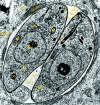Secretory traffic in the eukaryotic parasite Toxoplasma gondii: less is more
- PMID: 12011107
- PMCID: PMC2173860
- DOI: 10.1083/jcb.200112144
Secretory traffic in the eukaryotic parasite Toxoplasma gondii: less is more
Abstract
Name a single-celled eukaryote that boasts a small genome size, is easily cultivated in haploid form, for which a wide variety of molecular genetic tools are available, and that exhibits a simple, polarized secretory apparatus with a well-defined endoplasmic reticulum and Golgi that can serve as a model for understanding secretion. Got it? Now name a cell with all these attributes that contains at least a dozen distinct and morphologically well-defined intracellular organelles, including three distinct types of secretory vesicles and two endosymbiotic organelles. Not so sure anymore?
Figures



References
-
- Ajioka, J., J.C. Boothroyd, B.P. Brunk, A. Hehl, L. Hillier, I.D. Manger, M. Marra, G.C. Overton, D.S.. Roos, K.L. Wan, et al. 1998. Gene discovery by EST sequencing in Toxoplasma gondii reveals sequences restricted to Apicomplexa. Genome Res. 8:18–28. - PubMed
-
- Bahl, A., B.P. Brunk, R.L. Coppel, J. Crabtree, S.J. Diskin, M.J. Fraunholz, G.R. Grant, D. Gupta, R.L. Huestis, J.C. Kissinger, et al. 2002. PlasmoDB: the Plasmodium genome resource. An integrated database providing tools for accessing, analyzing and mapping expression and sequence data (both finished and unfinished). Nucleic Acids Res. 30:87–90. - PMC - PubMed

